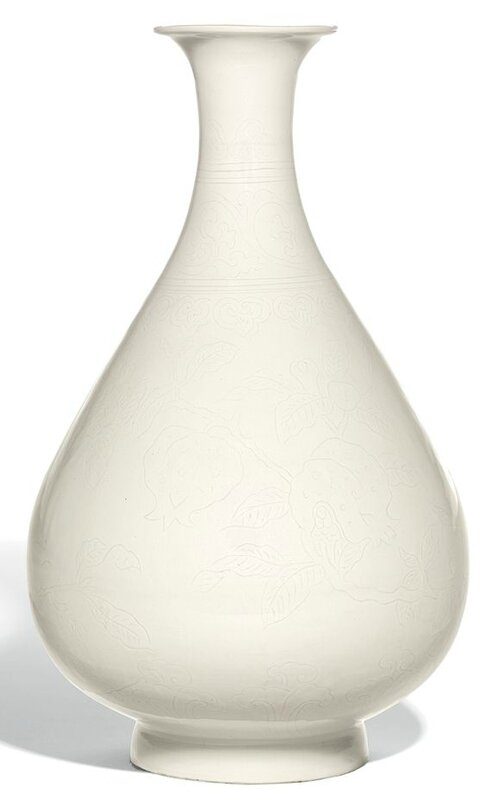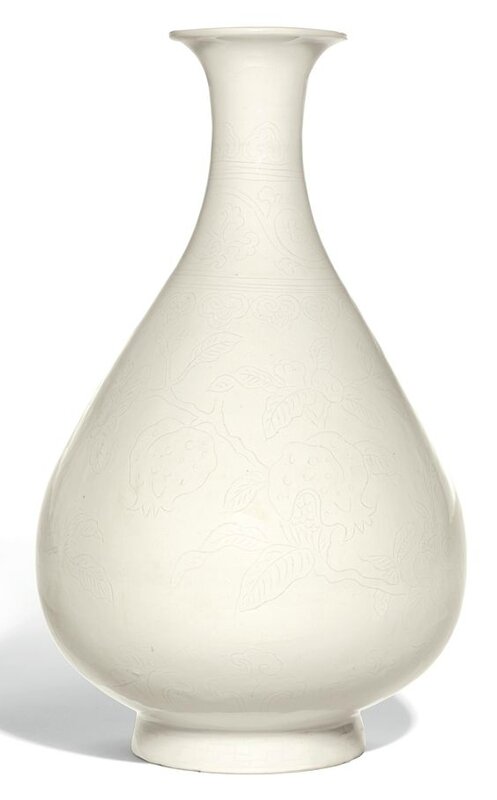An exceptional and rare incised ‘sweet-white’ vase, yuhuchunping, Ming dynasty, Yongle period (1403-1425)
Lot 16, An exceptional and rare incised ‘sweet-white’ vase, yuhuchunping, Ming dynasty, Yongle period (1403-1425). Estimate HK$6,000,000 — 8,000,000 (€701,658 - 935,545). Sold 19,280,000 HKD (2,485,578 USD). Photo Sotheby's.
elegantly potted with a pear-shaped body supported on a splayed foot, gracefully rising to a tall waisted neck flaring at the rim, finely incised with meandering branches of flowering and fruiting pomegranates, the fruits with dimpled skin and bursting with succulent seeds, all above a band of stylised lingzhi lappets, the neck decorated with a wide band of classic scroll between ruyi heads and quadruple line borders, skirted with a band of interlocking wan symbols at the foot, applied overall with an unctuous ‘sweet-white’ glaze - 32 cm, 12 5/8 in.
Provenance: Collection of H.R.N. Norton (d.1961-62).
Sotheby's London, 26th March 1963, lot 56 (£3800).
Bluett & Sons Ltd, London, 1963 (£3800).
Collection of Roger Pilkington (1928-69), from 1963 (£3800).
Bibliography: Adrian Joseph, Ming Porcelains: Their Origins and Development, London, 1971, pl. 94.
Note: No more exquisite, pure white porcelain was ever made than during the Yongle reign (1403-24) by the imperial kilns of Jingdezhen, Jiangxi province, and the present bottle is of a quality difficult to match even in that period. Since in the Yongle reign the ‘colour’ white was of the utmost importance for use in Buddhist ritual ceremonies, which the Emperor strongly patronised, monochrome white porcelains appear to have been particularly favoured at the Yongle imperial court, where the taste for blue-and-white developed only slowly. Imperial potters thus lavished more care onto the development of a special white glaze than in any other reign, in order to elevate these monochrome pieces to the highest rank. Yongle white wares are not simply porcelains without painted decoration. While the ideal glaze for blue-and-white porcelain is clear, colourless and translucent, basically invisible, to bring out the blue decoration to best effect, the requirements for a monochrome white piece are different. Here, the beauty lies in the glaze.
Yongle white wares are glazed with a particularly lush and mellow, slightly opaque, but brilliant white glaze, used in no other context, in China fittingly described as ‘sweet-white’ (tianbai), that gives the porcelain a superb, rich presence. The drawback often incurred with a ‘sweet-white’ glaze is that its slight opacity tends to obscure or obliterate incised decorations, which were popular for these white wares. The present piece is remarkable in this respect, since the glaze has this superb opulent quality, yet the incised pomegranate design is as distinct and clear to see, as if drawn with a pen. Although several whiteyuhuchun ping of the Yongle period are preserved, pieces of this excellence are hard to find.
The ‘sweet-white’ glaze is described by Nigel Wood (Chinese Glazes. Their Origins, Chemistry and Recreation, London, 1999, p.66) as consisting almost entirely of ‘glaze stone’ with little or no ‘glaze ash’, different from white glazes in other periods and from glazes used for blue-and-white porcelain at the same period. It created a superb surface that is a pleasure to behold as well as to hold, pure white without being dead, glossy without being cold, crisp and yet soft and smooth to the touch.
A very similar bottle incised with flowering and fruiting pomegranate branches is illustrated in The Tsui Museum of Art, Hong Kong, 1991, pl. 60; another was sold at Christie’s Hong Kong, 3rd November 1998, lot 918; and a third in our New York rooms, 22nd/23rd September 2004, lot 275.
A similar bottle incised with pomegranate sprays in quatrefoil panels is published in John Ayers, Chinese Ceramics in the Baur Collection, Geneva, 1999, vol. 1, pl. 60. Although many Yongle white porcelains are incised with designs also known from contemporary blue-and-white wares, the present pomegranate design is not recorded in a cobalt-blue version.
A fragmentary white bottle with flower-scroll design and Ottoman metal mounts is illustrated in Regina Krahl, Chinese Ceramics in the Topkapi Saray Museum, Istanbul, ed. John Ayers, London, 1986, vol. 2, no. 635. A related bottle but incised with lotus scrolls, published in Regina Krahl, Chinese Ceramics from the Meiyintang Collection, London, 1994-2010, vol. 4, no. 1631, was sold in our New York rooms, 23rd September 1997, lot 263 and in these rooms, 7th April 2011, lot 49, from the Meiyintang collection; and another bottle with reduced neck, apparently undecorated, was sold in our London rooms, 27th November 1973, lot 334.
Sotheby's. The Pilkington Collection of Chinese Art, Hong Kong, 06 avr. 2016, 10:00 AM

/https%3A%2F%2Fprofilepics.canalblog.com%2Fprofilepics%2F1%2F0%2F100183.jpg)
/https%3A%2F%2Fstorage.canalblog.com%2F03%2F02%2F119589%2F96711876_o.jpg)
/https%3A%2F%2Fstorage.canalblog.com%2F11%2F31%2F119589%2F94773502_o.jpg)
/https%3A%2F%2Fstorage.canalblog.com%2F20%2F83%2F119589%2F94772815_o.jpg)
/https%3A%2F%2Fstorage.canalblog.com%2F26%2F72%2F119589%2F75604929_o.jpg)
/https%3A%2F%2Fstorage.canalblog.com%2F59%2F60%2F119589%2F26458628_o.jpg)




/image%2F1371349%2F20240416%2Fob_65a1d8_telechargement-31.jpg)
/image%2F1371349%2F20240410%2Fob_645a50_2024-nyr-22642-0910-000-a-russet-paint.jpg)
/http%3A%2F%2Fstorage.canalblog.com%2F85%2F43%2F119589%2F129542325_o.jpg)
/http%3A%2F%2Fstorage.canalblog.com%2F48%2F20%2F119589%2F129532416_o.jpg)